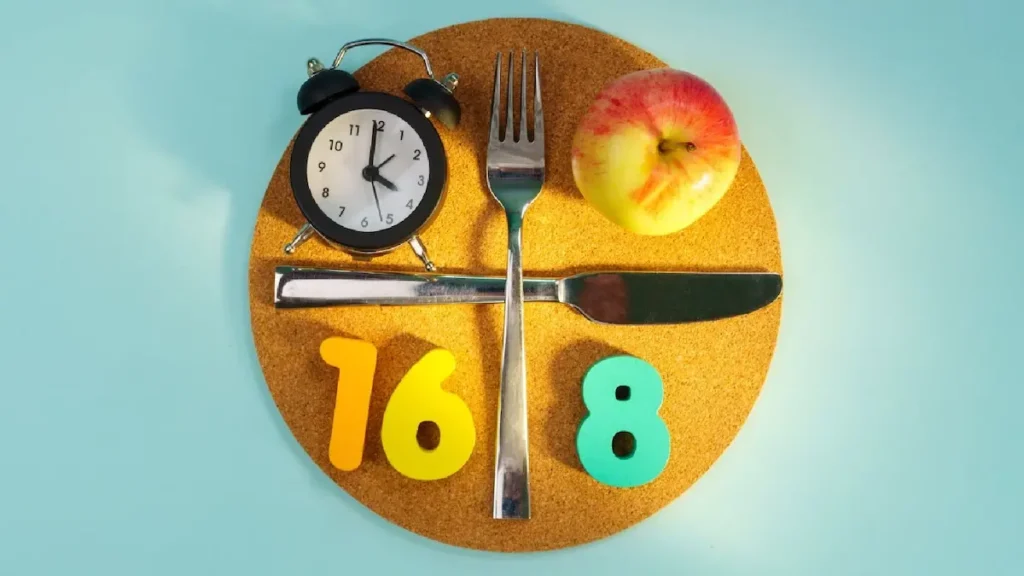Intermittent fasting (IF) is a relatively new approach to meal planning. Its goal is to improve health, normalize weight, and boost metabolic processes. This method is simple and convenient, making it suitable for many people. However, to maximize its benefits, it’s important to start correctly and avoid common mistakes.
What Is Intermittent Fasting – Types Of Fasting
Intermittent fasting is a way of eating where periods of food consumption alternate with fasting periods. It doesn’t restrict your food choices but instead focuses on when you eat. There are “eating windows” and fasting periods.
Main Types Of IF:
- 16/8: The most popular method, where you fast for 16 hours and eat within an 8-hour window (e.g., 12 PM-8 PM).
- 14/10: A lighter version allowing a 10-hour eating window.
- 5:2: Normal eating for five days a week, with calorie restriction (500-600 calories) for two days.
- Alternate-Day Fasting: Eat normally one day and reduce intake the next.
- OMAD (One Meal A Day): Consume all calories in one meal, typically within an hour.
Each regime has its pros and cons, so choose the one that suits you. Keep in mind that OMAD can be challenging and potentially less beneficial, while 14/10 closely resembles many people’s typical eating habits.
Intermittent Fasting – Preparation
Start any diet with an assessment of your health. If you have any medical conditions, consult a doctor first. Pregnant women should also avoid fasting. If you’re healthy and ready, follow these tips:
- Start Gradually: If you’re used to eating every 2-3 hours, abruptly transitioning to extended fasting can stress your body. Begin by reducing snacks or trying a 12/12 schedule (12 hours eating, 12 hours fasting).
- Prepare Your Body: Gradually cut out refined foods and excess sugar, which trigger hunger. Increase vegetables, proteins, and healthy fats in your meals. Stay hydrated to avoid dehydration.

Intermittent Fasting – What to Eat
IF doesn’t mean you can eat anything during your eating window. Your diet should be balanced and nutritious. Include:
- Proteins: Chicken, fish, eggs, legumes – these aid in satiety and muscle recovery.
- Healthy Fats: Avocado, nuts, olive oil, seeds – for long-lasting energy.
- Complex Carbohydrates: Whole-grain bread, brown rice, quinoa – for stable blood sugar levels.
- Vegetables and Greens: Packed with vitamins and fiber to support digestion.
- Water and Beverages: Staying hydrated is key. In addition to water, drink unsweetened green tea or black coffee, but avoid excessive caffeine to prevent dehydration.

Intermittent fasting – The Main Mistakes
Starting intermittent fasting requires awareness of common pitfalls, especially for beginners:
- Starting Too Aggressively: Many jump into strict schedules like 16/8 or OMAD, leading to stress and disappointment. Begin gradually, even with a 12/12 routine, and shorten the eating window over time.
- Under-Eating During The Eating Window: Drastic calorie restriction can cause weakness, fatigue, or dizziness. Ensure adequate calorie and nutrient intake.
- Overeating During Eating Hours: Some compensate for fasting by overeating, which negates the benefits of IF. Monitor portion sizes and food quality.
- Ignoring Body Signals: If you feel fatigued, experience headaches, or have trouble sleeping, consult a doctor. IF may not be suitable for everyone.
- Not Drinking Enough Water: Stay hydrated with water or unsweetened herbal teas during fasting periods.
How to Start Intermittent Fasting Correctly
To make intermittent fasting as comfortable and effective as possible, follow these recommendations:
- Listen to your body. Not all modes are equally suitable for every person. If you feel comfortable starting with 14/10, this is already a good result.
- Use auxiliary tools. There are many mobile apps that can help you track fasting periods, plan your diet, and monitor your progress.
- Add physical activity. Light physical activity, such as yoga or walking, can improve your results. However, avoid intense exercise during the fasting period, especially in the beginning.
- Set clear goals. Understand yourself. Understand what you expect – weight loss, improved health, increased energy. This way you can analyze the results.
Remember, intermittent fasting is not for everyone. If you experience constant discomfort, intense hunger, irritability, or loss of energy, don’t give up on yourself. Be prepared to reconsider your approach or choose a different diet.
Intermittent Fasting, Pros and Cons – video
To learn more about intermittent fasting, all its advantages and disadvantages, watch the video:
Conclusion
Intermittent fasting is a flexible and effective approach to eating. It can significantly benefit your health if started correctly. Focus on gradual adjustments, maintaining a balanced diet, and listening to your body. Start slow, avoid common mistakes, and adapt the routine to fit your lifestyle for the best results.
FAQs About Intermittent Fasting
Depending on starting weight and restrictions, 0.5-1 kg (1-2 lbs) is typical.
Opt for balanced meals with proteins, healthy fats, complex carbs, and minimal processed foods.
Initial changes may appear within 2-3 days, with more consistent results in 1-2 weeks if the regime is followed properly.











